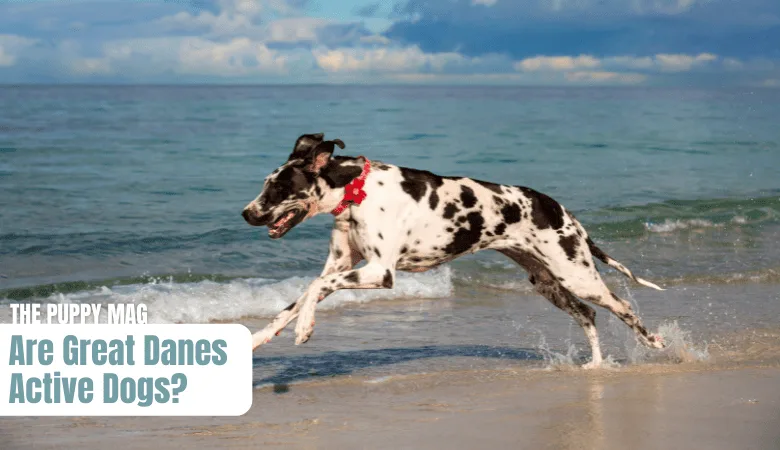Just how active are these friendly giants? Is it true that giant breeds like the Great Dane are less active and energetic than smaller breeds?
This article explains everything you want to know about Great Danes and their activity levels.

Table of Contents
How Active Are Great Danes?
Great Danes are very active.
Whenever a Great Dane isn’t sleeping, he’ll be right in the middle of the action always looking to play, exercise, run, and be active.
The best answer to this is that Great Danes enjoy being very active for the hours that they are actually awake…
Yep, Great Danes LOVE to sleep. 16-18 hours per day of sleep is normal for most Great Danes.
So can we still call Great Danes an active breed?
In my opinion, yes. Most people rightly assume that smaller breeds have more energy than their giant canine companions, and that’s generally true. But this doesn’t mean that Great Danes are the opposite of active.
Despite their size and sleeping habits, Great Danes are surprisingly athletic and really enjoy playing, running, being mobile, and exercising.
Why Great Danes Are Not a Lazy Breed
Another frequent question that many people ask and is closely tied to activity levels is whether Great Danes are a lazy breed?
Although I mentioned Great Danes love to sleep and nap around, they shouldn’t be considered a lazy breed.
Most owners would describe their Dane as the complete opposite of being lazy.
If you’re sitting on the couch they’ll love nothing more than to come and chill out right next to you (or on top of you). But this isn’t fueled by laziness, this is due to them being an incredibly affectionate breed. The moment you get up, they’ll be right there ready for action.
Lazy breeds tend to rest and nap calmly by themselves and typically show very little motivation to get up, exercise, or willingly exert energy when not necessary. Great Danes are certainly NOT like this.
They love to sleep, but the moment there’s a chance to play, go outside or be active, they are there!
Related article: Do great dane puppies have growing pains
Great Dane Activity Requirements
One thing every giant-breed owner must be very conscious about is the joint health of their dog.
There’s a fine balance between too little exercise and too much exercise when it comes to Great Danes. And admittedly, this can be tricky to find out.
Great Danes do need to remain active in order to keep their bodies strong and “working”. Yet, too much can overload their vulnerable joints and cause issues in the short and long term.
Great Danes still need their fair share of exercise…
The amount of exercise that is tolerable and beneficial for each Great Dane will vary depending on their age and health.
But in general, a healthy adult should receive 45-60 minutes of dedicated exercise per day, ideally split up into two walks.
Puppies, despite having more energy to burn should follow a specially-made exercise pan to avoid injuring their fragile joints, bones, and muscles. I link to an article in the next section that explains everything perfectly.
Great Dane Puppies Are Extremely Active
This likely doesn’t come as a surprise, but it’s still worth clarifying.
There’s a clear distinction between the activity levels of a Great Dane adult and a Great Dane puppy. Of course, GD puppies have an uncanny amount of energy, often labeled as hyperactive maniacs.
Plenty of mental stimulation and a safe amount of physical exercise is absolutely vital if you are to get a grip on a Great Dane puppy’s energy levels and behavior.
Joint Health for Great Danes
While Great Danes are fairly active, we have to consider their size, weight, and the impact that all this activity has on their joints.
Here are some basic, yet crucially important joint health tips for our giant friends:
- Exercise Moderation: Regular, low-impact exercise like swimming or gentle walks are beneficial. Avoid intense activities that can strain the joints.
- Healthy Diet: A balanced diet, rich in joint-friendly nutrients such as Omega-3 fatty acids, glucosamine, and chondroitin, is important.
- Weight Management: Preventing obesity is crucial, as extra weight puts added stress on joints.
- Regular Vet Visits: Early detection of joint issues through regular vet check-ups can lead to timely treatment, preventing further complications.
- Joint Supplements: Under your vet’s guidance, certain dietary supplements can aid joint health.
- Comfortable Environment: Providing a soft bed and a living space that minimizes the need for jumping or stair-climbing can protect your Great Dane’s joints.
Thank you for reading!
Great Dane Articles:
When do Great Dane puppies calm down (and how to help)
Can Great Danes go on long walks? Exercise levels for adults and puppies
